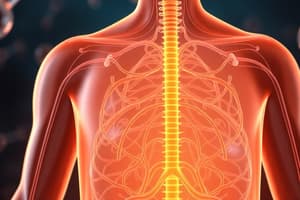Podcast
Questions and Answers
How are synthetic corticosteroids primarily metabolized within the body?
How are synthetic corticosteroids primarily metabolized within the body?
- Through renal excretion, remaining largely unchanged.
- Via hepatic metabolism, where they are broken down into inactive metabolites. (correct)
- Through metabolism in the adrenal cortex, modifying their hormonal activity.
- By direct degradation in circulating blood by plasma enzymes.
What is the primary mechanism by which glucocorticoids exert their effects on gene expression?
What is the primary mechanism by which glucocorticoids exert their effects on gene expression?
- Binding to intracellular receptors that then regulate gene transcription. (correct)
- Inhibiting the activity of RNA polymerase, thereby reducing overall gene transcription.
- Directly altering the DNA sequence of target genes.
- Modifying the post-translational modifications of histones, leading to chromatin remodeling.
Why is betamethasone preferred over other corticosteroids when aiming to promote lung maturation in a premature fetus?
Why is betamethasone preferred over other corticosteroids when aiming to promote lung maturation in a premature fetus?
- It potently stimulates surfactant production, directly accelerating lung maturation.
- It has a higher affinity for mineralocorticoid receptors, enhancing fluid reabsorption in the fetal lungs.
- It has a longer half-life in maternal circulation, providing prolonged exposure to the fetus.
- It exhibits minimal protein binding, facilitating its transfer across the placenta to the fetus. (correct)
How does the body respond to decreased cortisol production in the context of the metyrapone test?
How does the body respond to decreased cortisol production in the context of the metyrapone test?
Which statement accurately describes the mechanism of action of spironolactone?
Which statement accurately describes the mechanism of action of spironolactone?
What is the rationale behind tapering corticosteroids slowly after long-term use?
What is the rationale behind tapering corticosteroids slowly after long-term use?
What is the implication of synthetic corticosteroids binding mostly to albumin?
What is the implication of synthetic corticosteroids binding mostly to albumin?
Why are mineralocorticoids like fludrocortisone used in treating Addison's disease?
Why are mineralocorticoids like fludrocortisone used in treating Addison's disease?
How does ketoconazole exert its effects in treating Cushing's syndrome?
How does ketoconazole exert its effects in treating Cushing's syndrome?
What is the primary reason for the shift away from using ACTH administration towards adrenocortical steroids in clinical practice?
What is the primary reason for the shift away from using ACTH administration towards adrenocortical steroids in clinical practice?
What is the underlying mechanism by which glucocorticoids can lead to osteoporosis?
What is the underlying mechanism by which glucocorticoids can lead to osteoporosis?
How does aminoglutethimide reduce estrogen production?
How does aminoglutethimide reduce estrogen production?
What is the primary therapeutic advantage of using topical corticosteroids?
What is the primary therapeutic advantage of using topical corticosteroids?
How do glucocorticoids affect neutrophil counts in the blood?
How do glucocorticoids affect neutrophil counts in the blood?
What distinguishes mifepristone (RU-486) from other adrenocortical agents?
What distinguishes mifepristone (RU-486) from other adrenocortical agents?
How does the circadian rhythm influence cortisol plasma levels?
How does the circadian rhythm influence cortisol plasma levels?
What is the primary implication of the 'permissive effects' of cortisol in the body?
What is the primary implication of the 'permissive effects' of cortisol in the body?
What explains the link between long-term, high-dose corticosteroid therapy and the development of 'moon face'?
What explains the link between long-term, high-dose corticosteroid therapy and the development of 'moon face'?
In the context of congenital adrenal hyperplasia, why does a deficiency in 21 beta-hydroxylase lead to virilization?
In the context of congenital adrenal hyperplasia, why does a deficiency in 21 beta-hydroxylase lead to virilization?
What is the underlying mechanism by which glucocorticoids can induce peptic ulcers?
What is the underlying mechanism by which glucocorticoids can induce peptic ulcers?
Which of the following best describes the mechanism by which cortisol exerts its effects on target cells?
Which of the following best describes the mechanism by which cortisol exerts its effects on target cells?
In Addison's disease, why is it crucial to administer both glucocorticoids and mineralocorticoids?
In Addison's disease, why is it crucial to administer both glucocorticoids and mineralocorticoids?
What is the primary rationale for using the dexamethasone suppression test in diagnosing Cushing's syndrome?
What is the primary rationale for using the dexamethasone suppression test in diagnosing Cushing's syndrome?
How does fludrocortisone address the physiological deficits in patients with Addison's disease?
How does fludrocortisone address the physiological deficits in patients with Addison's disease?
Why might a patient with a breast tumor that requires estrogen for growth be prescribed aminoglutethimide?
Why might a patient with a breast tumor that requires estrogen for growth be prescribed aminoglutethimide?
What is the most critical consideration when discontinuing long-term corticosteroid therapy to avoid secondary adrenal insufficiency?
What is the most critical consideration when discontinuing long-term corticosteroid therapy to avoid secondary adrenal insufficiency?
How does the mechanism of action of mifepristone (RU-486) differ from that of ketoconazole in the treatment of Cushing's syndrome?
How does the mechanism of action of mifepristone (RU-486) differ from that of ketoconazole in the treatment of Cushing's syndrome?
Why is metyrapone specifically useful in diagnosing the etiology of Cushing's syndrome?
Why is metyrapone specifically useful in diagnosing the etiology of Cushing's syndrome?
What is the underlying mechanism by which glucocorticoids like cortisol can impair wound healing?
What is the underlying mechanism by which glucocorticoids like cortisol can impair wound healing?
How do mineralocorticoid antagonists, such as spironolactone, counteract the effects of excess aldosterone?
How do mineralocorticoid antagonists, such as spironolactone, counteract the effects of excess aldosterone?
A patient with Cushing's syndrome caused by an ectopic ACTH-producing tumor is being treated with mifepristone. What is the primary goal of this treatment?
A patient with Cushing's syndrome caused by an ectopic ACTH-producing tumor is being treated with mifepristone. What is the primary goal of this treatment?
How does cortisol's inhibition of phospholipase contribute to its anti-inflammatory effects?
How does cortisol's inhibition of phospholipase contribute to its anti-inflammatory effects?
Given that cortisol is known to have metabolic effects, which of the following is a direct metabolic consequence of increased cortisol levels?
Given that cortisol is known to have metabolic effects, which of the following is a direct metabolic consequence of increased cortisol levels?
A patient presents with hypertension, hypokalemia, and low plasma renin activity. Which adrenocortical hormone abnormality is most likely contributing to these findings?
A patient presents with hypertension, hypokalemia, and low plasma renin activity. Which adrenocortical hormone abnormality is most likely contributing to these findings?
Why is hydrocortisone, rather than a longer-acting corticosteroid, typically preferred for replacement therapy in Addison's disease?
Why is hydrocortisone, rather than a longer-acting corticosteroid, typically preferred for replacement therapy in Addison's disease?
How does etomidate's mechanism of action lead to its use in managing Cushing's syndrome?
How does etomidate's mechanism of action lead to its use in managing Cushing's syndrome?
According to current understanding, how do glucocorticoids affect circulating neutrophil counts?
According to current understanding, how do glucocorticoids affect circulating neutrophil counts?
What is the critical distinction between the mechanisms of action of spironolactone and eplerenone?
What is the critical distinction between the mechanisms of action of spironolactone and eplerenone?
How does the use of synthetic corticosteroids potentially lead to muscle weakness?
How does the use of synthetic corticosteroids potentially lead to muscle weakness?
What is the primary advantage of using locally acting corticosteroids, such as inhaled or topical formulations, compared to systemic corticosteroids?
What is the primary advantage of using locally acting corticosteroids, such as inhaled or topical formulations, compared to systemic corticosteroids?
Flashcards
Adrenocorticosteroids
Adrenocorticosteroids
Steroid hormones produced by the adrenal cortex that affect intermediary metabolism, immune function (Glucocorticoids), salt retention (Mineralocorticoids), and androgenic/estrogenic activity (Adrogens)
Hydrocortisone
Hydrocortisone
A glucocorticoid, the pharmaceutical preparation of Cortisol.
Permissive effects of cortisol
Permissive effects of cortisol
Restores the actions of natural hormones in the body.
Gluconeogenesis
Gluconeogenesis
Signup and view all the flashcards
Addison's Disease
Addison's Disease
Signup and view all the flashcards
Dexamethasone Suppression Test
Dexamethasone Suppression Test
Signup and view all the flashcards
Cortisol and Lung Maturation
Cortisol and Lung Maturation
Signup and view all the flashcards
Cushing's syndrome (as toxicity)
Cushing's syndrome (as toxicity)
Signup and view all the flashcards
Corticosteroid Special Precautions
Corticosteroid Special Precautions
Signup and view all the flashcards
Corticosteroid Contraindications
Corticosteroid Contraindications
Signup and view all the flashcards
Corticosteroid Dosage
Corticosteroid Dosage
Signup and view all the flashcards
Aldosterone
Aldosterone
Signup and view all the flashcards
Fludrocortisone
Fludrocortisone
Signup and view all the flashcards
Aminoglutethimide
Aminoglutethimide
Signup and view all the flashcards
Ketoconazole
Ketoconazole
Signup and view all the flashcards
Metyrapone
Metyrapone
Signup and view all the flashcards
Mifepristone (RU-486)
Mifepristone (RU-486)
Signup and view all the flashcards
Spironolactone
Spironolactone
Signup and view all the flashcards
Glucocorticoids
Glucocorticoids
Signup and view all the flashcards
Mineralocorticoids
Mineralocorticoids
Signup and view all the flashcards
Corticotropin-Releasing Hormone (CRH)
Corticotropin-Releasing Hormone (CRH)
Signup and view all the flashcards
Adrenocorticotropic Hormone (ACTH)
Adrenocorticotropic Hormone (ACTH)
Signup and view all the flashcards
Cortisol Mechanism of Action
Cortisol Mechanism of Action
Signup and view all the flashcards
Physiologic Effect of Cortisol
Physiologic Effect of Cortisol
Signup and view all the flashcards
Metabolic Effects of Cortisol
Metabolic Effects of Cortisol
Signup and view all the flashcards
Catabolic Effects of Cortisol
Catabolic Effects of Cortisol
Signup and view all the flashcards
Cortisol as Anti-inflammatory
Cortisol as Anti-inflammatory
Signup and view all the flashcards
Cortisol's Inhibition Action
Cortisol's Inhibition Action
Signup and view all the flashcards
Etomidate
Etomidate
Signup and view all the flashcards
Cushing Syndrome
Cushing Syndrome
Signup and view all the flashcards
Study Notes
Adrenocorticosteroids
- Glucocorticoids (cortisol) manage intermediate metabolism and immune function.
- Mineralocorticoids (aldosterone) handle salt retention.
- Androgens (DHEA) have adrogenic or estrogenic activity.
- The adrenal cortex produces two major classes of hormones: glucocorticoids and mineralocorticoids.
Cortisol (Hydrocortisone)
- Cortisol is the same as hydrocortisone; plasma levels fluctuate in a circadian rhythm driven by ACTH pulses.
- Cortisol mainly binds to corticosteroid-binding globulin (CBG), whereas cortisol loosely bound to albumin is considered "free".
- Only the "free" form of cortisol is active, synthetic corticosteroids primarily bind to albumin.
- Cells contain intracellular glucocorticoid receptors that regulate gene transcription (protein synthesis), resulting in long-term effects with a delay before biological action.
- Glucocorticoids regulate 10-20% of genes in cells
- Cortisol restores the actions of natural hormones, allowing for permissive effects in the body; response of smooth muscle to catecholamines is reduced without cortisol.
- Cortisol, also known as compound F, is a glucocorticoid that freely enters the cell and binds to a receptor in the cytoplasm
- The cortisol-receptor complex moves into the nucleus where transcription is initiated.
- Smooth muscle response to epinephrine is diminished when cortisol is low or absent.
- Cortisol and aldosterone, along with their derivatives, are steroids that are lipid soluble, built from cholesterol, and can pass directly through cell membranes
- These hormones affect gene function by altering protein synthesis.
HPA axis
- The hypothalamus produces corticotropin-releasing hormone (CRH), which arrives at the anterior pituitary, releasing adrenocorticotropin hormone (ACTH).
- ACTH travels to the adrenal glands, which then release cortisol.
Metabolic Effects of Cortisol
- Gluconeogenesis (increases plasma glucose levels)
- Glycogen synthesis
- Stimulates insulin release and lipogenesis
- Releases amino acids from muscle catabolism
- Maintains adequate glucose supply to the brain
Catabolic and Antianabolic Effects of Cortisol
- Decreased muscle mass
- Weakness and thinning of the skin
- Osteoporosis
- Reduces growth in children
- Catabolic and antianabolic effects explain why steroid hormones are often injected.
Anti-Inflammatory and Immunosuppressive Effects of Cortisol
- Reduces actions of white cells to set up inflammation and cytokine release
- Decreases counts of lymphocytes, monocytes, eosinophils, and basophils, while neutrophil counts increase.
- Reduces macrophage response to antigen stimulus
- Reduces prostaglandin and leukotriene levels
- Suppresses mast cell degranulation and causes vasoconstriction when applied topically
- These effects are profound and life-saving, cortisol is a gold standard for reducing inflammation.
- Cortisol controls the distribution of white cells and suppresses the effects on cytokines/chemokines.
- It inhibits phospholipase, the enzyme that removes arachidonic acid (a precursor of prostaglandins and leukotrienes).
Other Effects of Cortisol
- Low levels induce depression.
- Large doses can induce depression
- Promotes fat redistribution (moon face)
Synthetic Corticosteroids
- Synthesized using cholic acid from cattle or steroid sapogenins from plants.
- Disposition: Metabolized in the liver; alterations can modify receptor binding and physiological effects.
- Displays similar pharmacodynamics to cortisol (endogenous hormone).
- Most synthetics are produced from starting material from soybeans, which is costly and difficult.
Adrenal Insufficiency - Chronic (Addison's Disease)
- Symptoms include weakness, fatigue, weight loss, hypotension, and hyperpigmentation.
- Requires 20-30 mg/day of hydrocortisone.
- The drug causes salt loss through mineralocorticoid activity, necessitating salt-retaining fludrocortisone.
- Treatment involves a termination dosing regimen, gradually discontinuing the drug.
- Addison disease is often caused by chronic administration of a corticosteroid PO followed by abrupt termination of dosing
- During treatment the adrenals shut down, and when the drug is stopped, it takes weeks for the adrenal to resume hormone production.
Adrenal Insufficiency - Acute
- Requires immediate IV administration of 100 mg hydrocortisone.
Congenital Adrenal Hyperplasia
- Characterized by decreased cortisol synthesis.
- Is Due to decreases or lack of 21 beta hydroxylase.
- Precursors to cortisol are diverted to androgen synthesis, causing virilization.
Cushing's Syndrome
- Involves overproduction of ACTH due to pituitary or ACTH-producing tumors, or adrenal gland hyperplasia.
- Leads to rounded plethoric face, trunk obesity, muscle wasting, purple striae on the skin, mental disorders, hypertension, and diabetes.
- Treatment involves tumor removal.
- A possible case of increased steroid production by the adrenal glands
- ACTH (the anterior pituitary hormone that tells the adrenal glands to release hormones) is being overproduced by an ACTH producing tumor.
Aldosteronism (primary)
- Excess aldosterone production by adrenal tumor.
- Hypertension, muscle weakness, and tetany due to potassium loss.
- Low levels of renin and angio II.
- Spironolactone is an aldosterone receptor blocker
- Treated via removal of the tumor.
Dexamethasone Suppression Test
- Used for Cushing's Syndrome diagnosis.
- Dexamethasone 1 mg is administered orally at 11 PM.
- Normal plasma cortisol level at 8 AM: < 3 ug/dL; Cushing's: > 5 ug/dL.
- Dexamethasone cannot suppress excess ACTH production by tumors; normally, steroids will suppress ACTH through feed-back inhibition.
Lung Maturation in the Fetus
- Cortisol regulates maturation of the fetal lung.
- A large dose of cortisone to the mother can prevent respiratory distress syndrome in premature delivery.
- Betamethasone is used because low protein binding increases its transfer.
Corticosteroids and Nonadrenal Disorders
- Suppress inflammatory and immune responses.
- Reverse symptoms without curing the underlying disease.
- A major toxicity is Cushing’s syndrome
- Adverse drug reactions ADRs not usually seen with < 2 weeks duration of use
Metabolic Effects
- Iatrogenic Cushing’s syndrome often seen with > 2 weeks duration at 100 mg/day or more.
- Metabolic effects include rounding puffiness of the face, fat deposition, moon facies, fat redistribution into the trunk, facial hair growth, punctate acne, weight gain, increased need for insulin, increased glucose levels, thinning of the skin, bruising, osteoporosis, and poor wound healing
Other Complications with Corticosteroids
- Peptic ulcers.
- Clinical signs of mycotic infections masked by these drugs.
- Mood changes, which include depression and hypomania.
- Potassium loss and sodium retention.
Adrenal Suppression
- Seen following long term therapy
- May require taper off slowly, may take up to 12 months or more for cortisol production to return to normal.
Contraindications & Cautions
- Monitor for hyperglycemia, glycosuria, and sodium retention with hypertension.
- Assess for hypokalemia, peptic ulcer, osteoporosis, and hidden infections.
- Maintain the lowest possible dose, even if every other day.
Contraindications
- Use with great caution in patients with peptic ulcer, heart disease, hypertension with heart failure, TB, psychosis, diabetes, osteoporosis, glaucoma
ACTH vs Adrenocortical Steroids
- ACTH administration no longer widely used because it increases cortisol and androgen production.
Dosage
- Titrate dose to the lowest possible effective level, starting low and increasing until symptoms are suppressed.
- For inflammation and allergic responses, intermittent higher doses may be preferable to continuous low doses.
- Long term use: consider every other day dosing to provide a recovery period.
Special Dosage Forms
- Includes intra-articular injection, topical, ophthalmic drops, inhaled formulations for asthma, and hydrocortisone enemas for ulcerative colitis.
- These forms reduce systemic effects.
- Nasal sprays are used for allergic rhinitis.
- Creams are used widely in dermatology.
Mineralocorticoids
- Aldosterone and deoxycorticosterone are naturally occurring hormones.
- Fludrocortisone is the most widely used synthetic salt-retaining hormone.
- Aldosterone and fludrocortisone promote sodium reabsorption from the convoluted renal tubules, and water follows sodium.
- If sodium is retained in the blood, water and blood volume increase, as does blood pressure.
Aldosterone
- Synthesized in the zona glomerulosa of the adrenal cortex.
- Promotes sodium reabsorption from the distal convoluted tubules.
- Causes excretion of hydrogen ion and potassium.
- Excess causes hypokalemia, metabolic alkalosis, increased plasma volume, and hypertension.
- Mineralocorticoids bind to cytoplasmic receptors, especially in kidney cells.
- Major effect of the receptor-drug complex is increased expression of Na, K ATPase and the epithelial sodium channel.
- 100-200 ug/day secreted in normals and its metabolism is similar to cortisol.
Deoxycorticosterone (DOC)
- A precursor of aldosterone.
- Secretion is under ACTH control, unlike aldosterone.
Fludrocortisone
- Has both mineralocorticoid and glucocorticoid activity.
- It is the most widely used mineralocorticoid.
- It has a potent salt retaining activity.
- Doses used to replace decreased aldosterone are too low to have much of an anti-inflammatory effect.
- Fludrocortisone is the synthetic form of aldosterone.
Aminoglutethimide
- Blocks cholesterol conversion to pregnenolone, reducing all steroid production.
- Used to decrease estrogen production in breast cancer.
- Now largely replaced by tamoxifen for breast cancer.
- Inhibits the synthesis of all types of steroid hormones, including estrogen for growth in patients with breast tumors that require estrogen.
Ketoconazole
- A nonselective inhibitor of adrenal and gonadal steroid synthesis.
- Inhibits enzymes required for steroid biosynthesis.
- Effective at high doses (lower doses treat fungal infections).
- Used to treat Cushing’s syndrome.
- The antifungal ketoconazole is a non-specific inhibitor of adrenal steroid synthesis
Metyrapone
- A relatively selective inhibitor of steroid 11-hydroxylation, blocking cortisol and corticosterone biosynthesis.
- Used as a diagnostic test. Administer metyrapone. Normal pituitary will respond with increased ACTH output due to decreased cortisol production.
- Can be given to pregnant women with Cushing’s syndrome.
- A major ADR is salt, water retention and hirsutism due to diversion of cortisol precursors to androgen production.
- Metyrapone is a specific inhibitor of cortisol production.
Mifepristone (RU-486)
- AN antagonist at the steroid receptor.
- Blocks the glucocorticoid receptor.
- It Is used mostly for inoperable patients with ectopic ACTH production or adrenal carcinoma.
- Also used as a progesterone antagonist in women.
- Mifepristone is a glucocorticoid receptor antagonist (blocker).
- It has been used to treat Cushing Syndrome caused by ectopic ACTH production or an adrenal tumor and to terminate a pregnancy as it also blocks progesterone receptors.
Spironolactone
- Used to treat primary aldosteronism and to prepare patients for surgery.
- Used to treat hirsutism in women as it is an androgen antagonist and a diuretic.
- Adverse effects include hyperkalemia, cardiac arrhythmia, menstrual abnormalities, gynecomastia, sedation, headache, GI disturbances, and skin rashes.
- Used to treat aldosteronism, which is excess aldosterone usually due to an adrenal tumor.
- It also combats the effects of aldosterone i.e. sodium retention, potassium loss and hypertension.
Other Drugs
- Etomidate is used IV to treat Cushing Syndrome because it inhibits adrenal synthesis of steroids.
Cortisol Replacement medication includes
- betamethasone
- cortisone
- dexamethasone
- hydrocortisone
- methylprednisolone
- prednisolone
- trimcinolone
Mineralcorticoid medication includes
- fludrocortisone
Inhibitors of Cortisol medication includes
- ketoconazole
- mifepristone
- mitatane
Oral Glucocorticoids medication includes
- betamethasone
- cortisone
- dexamethasone
- hydrocortisone
- hydrocortisone cypionate
- methylprednisolone
- prednisolone
- prednisone
Parenteral Glucocorticoids
- betamethasone sodium phosphate
- dexamethasone acetate, sodium phosphate
- hydrocortisone actetate, sodium phosphate, sodium succinate
- methylprednisolone acetate, sodium succinate
- prednisolone acetate, sodium phosphate
- triamcinolone acetonide, hexacetonide
Adrenal Steroid Inhibitors medication includes
- ketoconazole
- mifepristone
- mitotane
Synthetic Corticosteroids - Acting Durations
- Short to Medium Acting: hydrocortisone, cortisone, prednisone, prednisolone, methylprednisolone.
- Intermediate Acting: triamcinolone.
- Long Acting: betamethasone, dexamethasone.
Studying That Suits You
Use AI to generate personalized quizzes and flashcards to suit your learning preferences.




